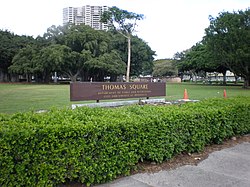Thomas Square
|
Thomas Square
|
|
 |
|
| Location | Bounded by King, Beretania, and Victoria Streets and Ward Avenue, Honolulu, Hawaii |
|---|---|
| Coordinates | 21°18′9″N 157°50′56″W / 21.30250°N 157.84889°WCoordinates: 21°18′9″N 157°50′56″W / 21.30250°N 157.84889°W |
| Area | 6.5 acres (2.6 ha) |
| Built | 1843 |
| NRHP reference # | 72000423 |
| Added to NRHP | April 25, 1972 |
Thomas Square is a park in Honolulu, Hawaii named for Admiral Richard Darton Thomas. The Privy Council voted to increase its boundaries on March 8, 1850, making Thomas Square the oldest city park in Hawaii.
In February 1843 Lord George Paulet on HMS Carysfort seized and occupied the Kingdom of Hawaii during the Paulet Affair.
On July 26 Admiral Richard Darton Thomas sailed into Honolulu harbor on his flagship HMS Dublin. He became Local Representative of the British Commission by out-ranking Paulet. His intention was to end the occupation. On July 31, he held the Hawaiian flag in his hands as he officially transferred the islands back to King Kamehameha III who said the words Ua Mau ke Ea o ka ʻĀina i ka Pono in a speech during a ceremony to mark his restoration. Roughly translated from the Hawaiian language it means "The sovereignty of the land is perpetuated in righteousness" and has become the state motto of Hawaii, incorporated into the Seal of Hawaii. The British flag set was pulled down and the Hawaiian flag was raised, followed by a series of 21 gun salutes from the Fort, the British ships Carysfort, Dublin, Hazzard, the American ship Constellation, and lastly by guns at the park.
Kamehameha III later named the place where the ceremony was held in Downtown Honolulu "Thomas Square" in Admiral Thomas's honor and dedicated it as a public park.
After the Privy Council demarcated Thomas Square's enlargement on March 8, 1850, the park was still merely a dusty field. A "cheap fence" was installed around 1873. Oats were sown and harvested and algaroba (kiawe) trees were planted soon after 1873, but there was still little shade at the park. It was around this time that the merchant Archibald Scott Cleghorn (husband of Princess Miriam Likelike, father of Princess Kaʻiulani, and brother-in-law of Kalākaua and Liliuokalani) began stewarding Thomas Square and Emma Square (the only two parks in Honolulu at that point). By 1883, Cleghorn had approved Robert Stirling's park design which laid out a series of circles and semi-circles for paths. Since Honolulu's treasury was in "dire condition" at the time, Cleghorn brought banyan trees from ʻĀinahau, his Waikiki estate, to plant and create more shade. He also asked his friends for money to design and build a bandstand, seating, and add more planting. Within several years, the bandstand was designed and installed by Mr. F. Wilhelm while more shrubs and trees were planted. The improved park celebrated a successful grand opening on April 7, 1887 where the Royal Hawaiian Band performed to a huge crowd.
...
Wikipedia

